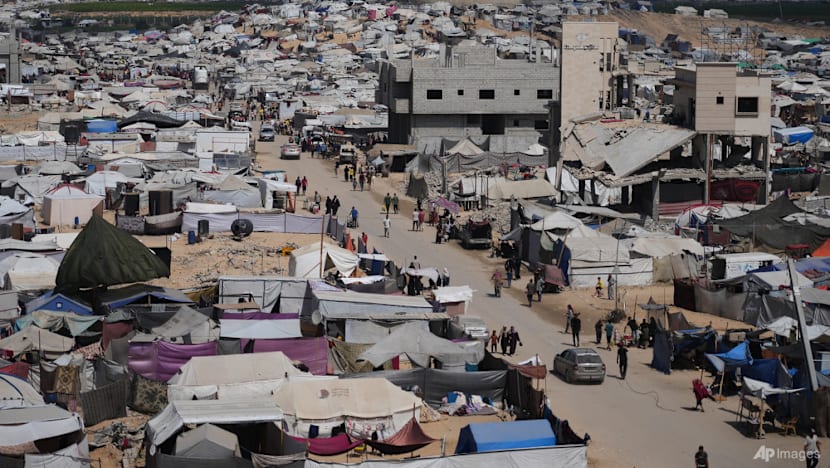Snap Insight: Trump’s Gaza peace plan – some cause for optimism, but will it be enough?
Success will require an extraordinary amount of heavy lifting from a distracted America, says NUS Middle East Institute’s Carl Skadian.

Displaced Palestinians walk through a tent camp in Muwasi, an area that Israel has designated as a safe zone, in Khan Younis southern Gaza Strip, on Sep 29, 2025. (Photo: AP/Jehad Alshrafi)

This audio is generated by an AI tool.
SINGAPORE: Perhaps the first question anyone should ask about United States President Donald Trump’s newest plan to end the war in Gaza is: “What is so newsworthy about this?”
After all, proposals to end the nearly two-year-long war have come and gone several times without changing anything, apart from deepening the misery of Gazans, and increasing the opprobrium towards Israel, particularly in the West.
There are several parts to the answer – some provide optimism that a breakthrough may be close at hand, others less so.
SOME REASONS FOR OPTIMISM
On the former, the buy-in for the proposal from Israel and others around the world, including Saudi Arabia, Indonesia and Türkiye, marks a key step forward, adding diplomatic pressure to what the US warns will be a totally unfettered Israeli military steamroller.
As if it were not clear enough, Hamas has been presented with an ultimatum: Agree, or else.
Mr Trump, who has reportedly been irritated by Israeli Prime Minister Benjamin Netanyahu – particularly over the strike on US ally Qatar just four weeks ago – did not mince words about what “or else” means: If Hamas does not agree, Israel would have the US’ “full backing to finish the job of destroying the threat”.
Mr Netanyahu grabbed the bit with both hands. “If Hamas rejects your plan… Israel will finish the job by itself,” he said, adding that “this can be done the easy way, or … the hard way.”
Another encouraging sign is that talk of forcing Palestinians out of Gaza is off the table – for now, at least. In a shift from Mr Trump’s earlier statements, the proposal states that “no one will be forced to leave Gaza”. Instead, it dangles the opportunity that Gazans could be enlisted in the drive for a better tomorrow.
The plan is also explicit that Israel “will not occupy or annex Gaza” – backing down from a plan that drew sharp international criticism – and will progressively hand over occupied territory to a temporary international security force.
WILL HAMAS ACCEPT?
However, the 800-pound gorilla is still in the room. The peace plan contains elements that Hamas has rejected outright in the past – including giving up power and disarmament – and there is little to suggest that the militant group will now sign its own death warrant.
Indeed, while a senior official said it would examine the proposal, he added that it was not part of the negotiations, and all but admitted that it was presented with a fait accompli.
Another complication is the ambiguity surrounding future Palestinian statehood. According to the text of the proposal, conditions for a “credible pathway to Palestinian self-determination and statehood, which we recognise as the aspiration of the Palestinian people” may be in place in some far-off future when redevelopment of Gaza and a murky reform process of the Palestinian Authority is carried out.
Beyond calling for an inter-faith dialogue process based on values of tolerance and peaceful co-existence, and a reference to “various proposals”, the peace plan stays silent on what the reform process actually means, or how it will be measured.
AMERICAN HEAVY LIFTING REQUIRED
Finally, the success of the proposal depends largely on an extraordinary amount of American heavy lifting, particularly on the part of Mr Trump, the chairman of the so-called “Board of Peace” that will oversee the next steps.
Beyond Mr Trump’s pattern of shifting his priorities from one week to the next – Ukraine is a case in point – the volatility of US politics is another complicating factor.

There are already signs that the MAGA movement is fraying at the edges, with dissenting voices over US involvement abroad, among others, making themselves heard. Then, there is also the question of American support for Israel, which, according to a recent poll, has significantly declined.
Given these factors, it is difficult to see a way ahead for the current proposal.
Hamas has been intransigent even when it appeared advantageous for it to secure some sort of peace in the past. It is now even more firmly wedged between a rock and a hard place, but has shown no signs of relenting.
Israel has been equally immovable in the face of growing domestic and international pressure.
The US is thus the only one capable of forcing the needle to move. Given its growing distractions, however, the question of whether it can stay engaged in the task at hand remains valid.
Carl Skadian, a former journalist and editor for 30 years, is deputy director at the Middle East Institute, National University of Singapore.

















